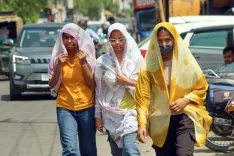How Has Delhi's AQI Improved to 88? Sirsa Attributes It to Ground-Level Action

Synopsis
Key Takeaways
- Delhi's AQI has improved to 88, indicating satisfactory air quality.
- Key pollution hotspots have reported satisfactory levels.
- Efforts include mechanized sweeping and dust control measures.
- 190 clean air days recorded in 2025 so far.
- Government initiatives show that cleaner air is possible with sustained action.
New Delhi, Oct 3 (NationPress) Following the Dussehra celebrations with the burning of Ravana effigies, Delhi's Environment Minister Manjinder Singh Sirsa announced a remarkable enhancement in the city's air quality, with the Air Quality Index (AQI) falling to 88, placing it in the Satisfactory category.
Two critical pollution hotspots in the city, Narela (66) and Mundka (76), have also shown ‘Satisfactory’ AQI levels, indicating the effectiveness of rigorous and targeted measures implemented, he stated.
As October typically sees an uptick in pollution, Sirsa attributed this positive shift to unwavering ground-level efforts.
“Today’s satisfactory AQI in October is the strongest evidence that initiatives such as mechanized sweeping, misting, dust control at construction sites, and bio-mining of legacy waste are yielding results. This achievement is due to relentless 24x7 environmental actions — not mere luck,” he expressed in a statement.
He stressed that the improvement in Delhi’s air quality is no longer solely dependent on weather conditions. “The clean air we are experiencing today is the result of effective policies, enforcement, and collaboration. Delhi is demonstrating that with determination, systematic approaches, and ongoing actions, cleaner air can be both achievable and sustainable,” he stated.
This year, Delhi has already achieved 190 clean air days from January 1 to October 3, 2025 — the highest recorded for this period in nearly ten years.
This performance sets 2025 on a path to potentially exceed all previous years, barring 2020 when the city experienced 227 clean air days due to pandemic restrictions.
“That record is now within reach, paving the way for a remarkable shift in Delhi’s battle for cleaner air,” he remarked.
Emphasizing the governance model, the Minister remarked: “Under the insightful leadership of Prime Minister Narendra Modi and the adept guidance of Chief Minister Rekha Gupta, Delhi is transitioning from temporary fixes to sustainable solutions. The improvement in October AQI reflects the power of this proactive strategy.”
“This clean-air transformation is not coincidental — it results from multiple coordinated interventions. From enhancing Delhi’s green cover through extensive plantation initiatives to mechanized road sweeping, strict dust management at C&D sites, and mandatory anti-smog guns for large commercial projects, alongside bio-mining of legacy waste, every measure is being implemented with discipline,” he said.
“We have installed misting systems in pollution hotspots, implemented centralized monitoring for immediate responses, and ensured timely garbage collection alongside ongoing road constructions and repairs. Each of these actions contributes to the broader improvement cycle, generating visible and measurable enhancements in Delhi’s air quality,” Sirsa added.
Presenting a report, the Minister highlighted that civic actions in the last 24 hours included: removal of 10,869 MT of garbage, sweeping 6,265 km of roads, lifting 2,171 MT of C&D waste, and bio-mining 8,894 MT of legacy waste — with Bhalaswa contributing 3,839 MT, Okhla 2,547 MT, and Ghazipur 2,508 MT.









